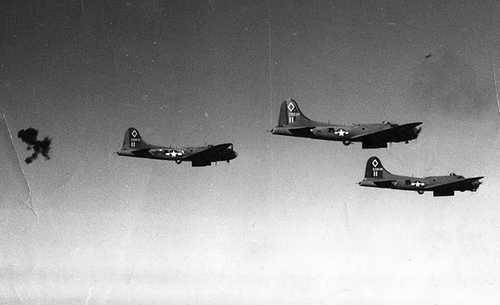
US Army Air Force
Bomb run
99th Bomb Group Association
Flying Fortress of the USAAF’s 99th BG, 15th Air Force, running over the target: note the bomb bays open and the smoke of an AA’s shell. Again from the Pilot Training Manual of the B-17 Flying Fortress: ” Consider the following conditions which affect the bomb dropped from an airplane: ALTITUDE: Controlled by the pilot. Determines the length of time the bomb is sustained in flight and affected by atmospheric conditions, thus affecting the range (forward travel of the bomb) and deflection (distance the bomb drifts in a crosswind with respect to airplane's ground track). TRUE AIRSPEED: Controlled by the pilot. The measure of the speed of the airplane through the air. It is this speed which is imparted to the bomb and which gives the bomb its initial forward velocity and, therefore, affects the trail of the bomb, or the distance the bomb lags behind the airplane at the instant of impact. BOMB BALLISTICS: Size, shape and density of the bomb, which determines its air resistance. Bombardier uses bomb ballistics tables to account for type of bomb. TRAIL: Horizontal distance the bomb is behind the airplane at the instant of impact. This value, obtained from bombing tables, is set in the sight by the bombardier. Trail is affected by altitude, airspeed, bomb ballistics and air density, the first three factors being controlled by the pilot. ACTUAL TIME OF FALL: Length of time the bomb is sustained in air from instant of release to instant of impact. Affected by altitude, type of bomb and air density. Pilot controls altitude to obtain a definite actual time of fall. GROUNDSPEED: The speed of the airplane in relation to the earth's surface. Groundspeed affects the range of the bomb and varies with the airspeed, controlled by the pilot. Bombardier enters groundspeed in the bombsight through synchronization on the target. During this process the pilot must maintain the correct altitude and constant airspeed. DRIFT: Determined by the direction and velocity of the wind, which determines the distance the bomb will travel downwind from the airplane from the instant the bomb is released to its instant of impact. Drift is set on the bombsight by the bombardier during the process of synchronization and setting up course. The above conditions indicate that the pilot plays an important part in determining the proper point of release of the bomb. Moreover, throughout the course of the run, as explained below, there are certain preliminaries and techniques which the pilot must understand to insure accuracy and minimum loss of time. Prior to takeoff the pilot must ascertain that the airplane's flight instruments have been checked and found accurate. These are the altimeter, airspeed indicator, free air temperature gauge and all gyro instruments. These instruments must be used to determine accurately the airplane's attitude”. Victor Sierra
2716 Views
6/5/2012
